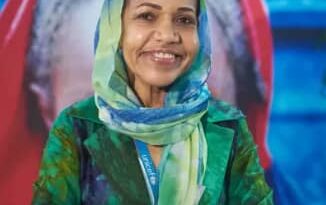Kano’s Forgotten Clinics: A story of Neglect and Resilience
By Hauwa Sani, Kano
Across Kano State, primary health centers (PHCs)—the backbone of the healthcare system—are crumbling under the weight of years of neglect, chronic underfunding, and decaying infrastructure. From Gwarzo to Shanono, Nassarawa to Sumaila, and Tarauni, communities are left to fend for themselves, often resorting to desperate measures to access even the most basic healthcare services.
Broken Promises, Abandoned Buildings
In Badari Village, Gwarzo LGA, the community’s only PHC collapsed during the rainy season five years ago. Since then, healthcare services have been running out of a borrowed structure within the local palace, with community elders pooling personal resources to make it usable.
“We had no choice,” said a community health worker. “Without government intervention, we had to take matters into our own hands just to keep the clinic functional.”

In Lakwaya Village, also in Gwarzo LGA, the situation mirrors that of many other communities. For years, the health center operated out of a small shop until a local chairman funded the construction of a basic building. But while the structure now exists, it remains grossly unequipped—no beds, no medical tools, and no water supply.
“It’s heartbreaking,” said the officer in charge at Lakwaya. “Youth loiter around the empty rooms, and at times, even livestock wander into the facility.”
At the Goran Dutse health post in Shanono LGA, despite receiving support from the Federal Government’s Basic Primary Health Care Fund (BHCPF), health workers still face daily challenges. Water must be purchased from a nearby dam at ₦100 per gallon, and electricity is only available when staff can afford to fuel the generator.
“Sometimes we go days without light or water,” said a Community Health Extension Worker (CHEW) at Goran Dutse. “We do our best, but how can you safely deliver babies under such conditions?”
In Sabon Layi Kara PHC, Gwarzo LGA, the story is equally grim. Most of the building collapsed long ago, and repairs have only been possible through funds raised by the village head and community elders. The ceiling, for instance, was reportedly sourced from the local mosque to patch the damaged structure. According to a health worker there, the facility has never undergone formal renovation, and the staff go unpaid.

At Yan Shadu Health Post in Shanono LGA, health workers report receiving no support whatsoever. The facility, built over 30 years ago by a politician, has never seen a formal renovation. Any repairs have been made possible only through small contributions from community members, local leaders, and elders. Waste is disposed of in an open pit and burned—a clear indicator of poor sanitation and lack of basic waste management systems.
Meanwhile, in Tarauni LGA, the Babban Giji Primary Health Center tells another story of neglect turned around by private intervention. Once overrun by weeds and rendered non-functional, the facility was renovated through the efforts of a wealthy community member. According to a long-time female resident of Sallare Babban Giji, the benefactor named the facility after his late father, calling it the Alhaji Muhammad Lawan Maihula Primary Health Center.
However, the government did not officially approve the name change, so it continues to be referred to as Babban Giji PHC in public records.

The Kokiya Health Post in Shanono LGA has two buildings and a limited supply of equipment, but the structures are in a state of serious disrepair. Although officials claim a renovation was carried out three years ago, the facility remains dusty, the toilets are broken, and the entire environment is poorly maintained and unorganized—far from suitable for delivering healthcare.
In Jisai Health Post, Sumaila LGA, the situation is even more dire. A community extension worker described the facility as lacking a roof, beds, a pharmacy, and staff. As the visit ended, he followed the reporter outside to explain another pressing concern: the absence of a fence or gate. “When we’re giving injections, children peek through and laugh at patients, creating noise and disturbance. Even when we send them away, they come back, sometimes joined by schoolchildren during break hours,” he said. “It’s very discouraging—we need proper fencing and renovations.”
In Burnabus Health Post, Sumaila LGA, the facility was built entirely by the community over 40 years ago and has never received any form of renovation. A community leader noted that it was never a government project to begin with, and since then, no support has been provided. “We have only one health worker and no government-supplied medication or personnel,” he explained.
At Yuu Health Post, also in Sumaila LGA, part of the building has collapsed. With limited resources and support from the community leader, some areas have been patched up, but the need for full renovation remains urgent. A community extension worker expressed concern over the deplorable conditions. “During the rainy season, I’ve seen the health worker attend to patients while mopping up water inside the facility. It’s heartbreaking.”
In Haye Health Post, Nassarawa LGA, the story is equally concerning. The long-abandoned outpost has become a shelter for squatters and stray animals. The building is small and offers no privacy. Patients often complain that their consultations can be overheard from outside. “During immunization days, the place is so crowded that people sit on the floor or mats all around the premises,” said the officer in charge. “We’ve sent petitions multiple times, but nothing has changed.”
“We feel forgotten,” one of the health workers added. “It’s like we don’t matter to the authorities.”
Despite these grim realities, the resilience of the affected communities is remarkable. Local leaders often mobilize funds to repair roofs, construct temporary shelters, or recruit volunteer health workers. In many villages, women’s groups have formed committees to monitor pregnant women and organize emergency transportation when labor begins.
The plight of Kano’s Abandoned PHCs call for urgent Attention

“We are our own saviors,” said one community health worker. “We can’t afford to wait any longer.”
A health expert emphasized, “Primary health care is the first line of defense for any community. If it fails, the entire health system becomes overwhelmed.”
For communities across Gwarzo, Shanono, Sumaila, Nassarawa, and Tarauni LGAs, renewed government attention and investment in primary healthcare is not just desirable—it is a matter of life and death.

This story was produced for the Frontline investigative program and supported by the Africa Data Hub and Orodata Science.





